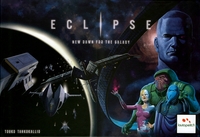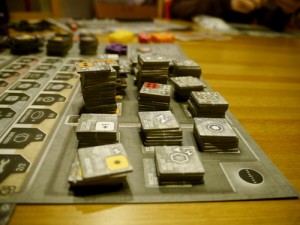Eclipse: New Dawn for the Galaxy
By Fred Manzo
Eclipse: New Dawn for the Galaxy is a 4x Science Fiction resource management game designed by Touko Tahkokallio and published in 2011 by such publishers as Asmodee and Lautapelit.
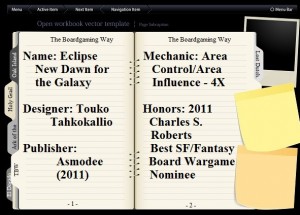 It’s now rated as the number 6 Strategy AND Board game on Boardgamegeek, so it’s hot.
It’s now rated as the number 6 Strategy AND Board game on Boardgamegeek, so it’s hot.
As I’ve always liked building my own space empire and as I’ve heard good things about Eclipse, both online and from friends, I couldn’t wait to give it a try.
Well, as of today, I’ve only played it four or five times but I think that’s enough to form an opinion. And in general I’d agree this game meets the hype that’s been generated around it. But then again, how bad can a game be that was a 2011 Charles Roberts Best Science-Fiction or Fantasy Board Wargaming Nominee?
Eclipse, in any event, is an exceptional implementation of the 4X theme. (That is, players eXplore, eXploit, eXpand and, finally, eXterminate). Think of it as Power Grid meets Twilight Imperium. After all, it’s chock full of tiles, cubes, discs, tracks, chits, aliens, interceptors and dreadnoughts. In fact, it reminds me of such similar games as Stellar Conquest, but without spreadsheets or Space Empires 4X with tracks.
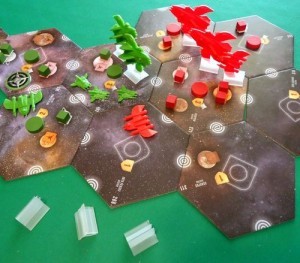
A mid-game example of play, but with mounted ship pieces. some players find mounting their ship pieces saves space on a playing field that can become crowded.
It’s said Eclipse can be played in 30 minutes per player with experience, which translates into a 2.5 hour game with 5 players. But I’d think with a couple of new players, a question or two every turn and someone who suffer from paralysis by analysis you’ll find 4 hour games common. While that’s not particularly out of line for a wargame, for a Euro it’s practically an epic.
Now, this game is exceptional, but it’s not perfect. First off, 4x is not for everyone no matter how well it was implemented and second, personally, I would have preferred its combat be more tactical and take up a greater portion of the game.
But these are relatively minor complaints. More to the point, its rules are clear, its mechanics are smooth and its play is deep. And as a bonus it has an awful lot of re-play value.
Yes, your first game will be long and slow, with an excessive set-up time and with every new player asking a dozen questions. But, while Eclipse does have a steep learning curve, if you stick with it you will be rewarded.
For instance, you will discover that it elegantly modifies the importance of its features as the game progresses. It then becomes the player’s responsibility to re-focus his strategy as he sees fit. So, in the early going players might concentrate on exploration and economic growth, in the mid-game on research and upgrades to their fleets and in the late game on military construction and combat.
Though, one of the things I’ve always wondered about 4X games is why they all seem to have the same premise. For instance, they usually start with 4 civilizations (E.G., Warparty and Conquest of Nerath) that are all at the same technological, political, economic, military and social level of development when they make First Contact. Why not throw in a scenario similar to the one used in Frank Chadwick’s “Imperium“ (not Twilight Imperium), in which an old, powerful, but basically disinterested Empire comes into conflict with an interstellar upstart called Earth? Or, why not include that hard-core SF staple, the Hivemind?
Anyway, I’d describe Eclipse as a detailed and theme heavy Eurogame, with a strong trace of Wargaming.
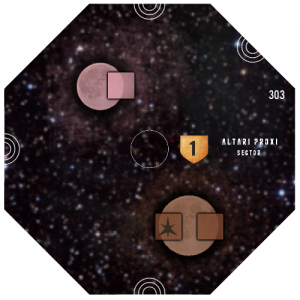 A typical tile contains one solar system. This one has three planets. The orangish planets produce money, pink planets produce science and brown planets produce materials. The brown planet to the right (the one with a star symbol) needs to be technologically modified before it can become productive. Its twin produces materials without tech upgrades. The shield signifies this system is worth 1 victory point at the end of the game. The concentric circle halves signify wormholes. They need to be matched on the adjacent tile in order to produce a working natural wormhole.
A typical tile contains one solar system. This one has three planets. The orangish planets produce money, pink planets produce science and brown planets produce materials. The brown planet to the right (the one with a star symbol) needs to be technologically modified before it can become productive. Its twin produces materials without tech upgrades. The shield signifies this system is worth 1 victory point at the end of the game. The concentric circle halves signify wormholes. They need to be matched on the adjacent tile in order to produce a working natural wormhole.
That is, players start in their home system with one interceptor and a small economy. They then expand outward by placing tiles adjacent to their empire until they come into contact with either the Galactic Center or their neighbor. These new tiles will usually reveal ready to be absorbed – and empty – solar systems, or non-player character (NPC) alien civilizations, random wormholes and the occasional abandoned ancient artifact.
However, early in the game the halves of a wormhole need to be matched on an adjacent tile in order to create a usable Faster-Than-Light (FTL) transportation system. Later in the game due to tech research, a wormhole generator can be obtained. So the placement and orientation of tiles, both offensively and defensively, becomes important early on: Offensively, by creating a direct invasion pathway to a neighboring empire and defensively by orienting new tiles and their wormhole halves in such a way that there is no pathway between your Homeworld and your neighbors.mmmmmmmmmmmmmmm
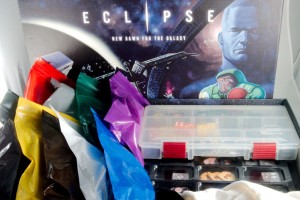
Eclipse comes with 12 playable factions – 6 human and 6 aliens, but only 2 – 6 are ever used at one time.
All these activities, however, revolve around the size of a player’s economy, which in turn depends on the types of planets that make up his empire. Apparently, all a growing Space Empire needs is Money, Scientific Knowledge and the Materials produced on them to expand. The Money keeps an empire running, Scientific Knowledge lets it develop ever higher levels of technology and Materials allow it to build a fleet.
But, in order to physically upgrade a space fleet its first necessary to upgrade the various branches of an empire’s technological base.
Now, in Eclipse, all technology is divided into three parts: Military, Nano and Grid. And while there is overlapping between these branches, in general, military tech directly helps a fleet, nano technology helps both the fleet and the economy, depending on the tech involved and grid technology mostly helps an economy. As no empire has the time or resources to buy all the tech options that become available each turn, a good player needs to stay focused.
The Galaxy
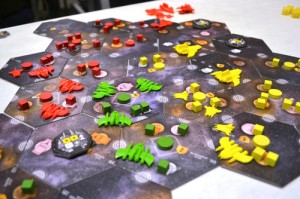
An example of a late stage 3-player game. The large multi-colored disc on a tile in the lower left hand corner indicates that star system is controlled by a non-player character (NPC) alien – BGG.
Eclipse’s galaxy, on the other hand, is made up of all the tiles in play, including a fortified Galactic Center, much like Nexus Ops, and your and your opponent’s Empires. While these empires, in turn, consist of all the planets a player controls plus his fleet of Starbases, Interceptors, Cruisers and Dreadnoughts plus any Orbitals or Monoliths he managed to build.
(Monoliths are worth 3 Victory Points and Orbitals are space colonies that can be built in systems under a player’s control.)
Orbital colonies, in particular, are a quick way of expanding an empire’s population without incurring the added expense of exploration.But like most things in Eclipse you’ll need to research a specific technology before you’ll be able to start their construction. Orbitals are especially important during the middle and late game or when an Empire becomes hemmed in.
Besides a tile-generated Galaxy and each player’s own control panel, the game also includes a common tech supply board, which holds all the available technology options. These options, however, will vary as the game progresses due to random re-supply draws each turn.
As may be apparent, this is the kind of game that you will not be comfortable playing until your third or so time. It’s that deep. Or as some people say, slow. There are plenty of chits with plenty of symbols that come in plenty of shapes and they are all important. But to put a better spin on it, for the first third of a game each player is free to develop his empire as he alone sees fit. What type of empire he decides to build being strictly up to him and until First Contact occurs there simply is no chance of combat or conquest. And First Contact will not come as a surprise. Now some people find this pace of development intriguing. And some people call it “multi-player solitaire.” So, if sitting quietly for an hour or so while you prepare to meet your rambunctious neighbor in deep space combat doesn’t intrigue you, I’d guess Eclipse is not for you. Consider yourself warned.
However, many, many people find the whole idea of independently developing their own Space Empire just their cup of tea. If that’s you, this game is a must buy. But it does require a bit of luck to win. This is not chess. In other words, which tiles appear, and in which order, which tech counters become available and which bonus chits are pulled all have an effect on a game. For example, if a game starts off with your home system hemmed in by aliens and un-usable wormholes, sorry, your budding Empire is in big trouble.
But, while luck plays a part in the health of your empire, it’s not so great a part that it can be depended upon to wreck your plans game after game (as in Kingmaker or Arkham Horror). Fortunately, due to the depth of the game, any bad luck you run into can usually be mitigated by re-directing your strategic focus.
The Rules:
As for Eclipse’s rules, I’d say they are somewhere around 24 pages in length, but with plenty of illustration they aren’t anywhere near as long as that number implies. Minus the pictures I’d think the rules themselves amount to, say, 12 pages, but that doesn’t include another 6 or 7 pages of backstory, FAQs and player’s aids.
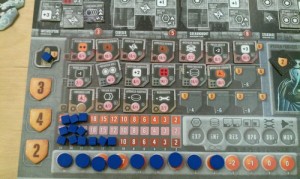
An example of a player’s control panel. The status of a player’s fleet can be seen across the very top. Below that is his tech status and below that his economic status (the cubes on the left) and his Action Phase options (the gray circles on the right). Along the bottom of his panel the disc track indicates the total costs per turn of running his empire. The yellow shields running down the left hand edge show some of the Victory Points the player earned during play – BGG.
In any event, a game runs 9 turns, with each turn consisting of:
I. The Action Phase – “Players take actions clockwise, one action at a time” until everyone passes. In a nice touch, the first player to pass in one turn is the first player to go in the next. During each round of an Action Phase a player may conduct one of the following:
A. Exploration – allows you to pick the location of a new tile and its class. For example, the tiles are labeled Class I, II, and III, with Class I tiles being those between your Homeworld and the Galactic Center, Class II are those placed at the same distance from the center as your Homeworld and Class III are the tiles at a greater distance from the center then your home system. The main difference between them being that those closer to the Galactic Center have a greater chance of containing NPC aliens. (Actually, out of 8 Class I tiles four have aliens or 50%, out of 11 Class II tiles three have aliens or 27.3% and out of 18 Class III tiles 4 have aliens or 22%.)
In an example of the amount of thought that has been put into this game, players can even refuse to place a “bad” tile. That is, one having NPC aliens. They waste this action, true, but they can place the bad tile aside. This not only allows them to mitigate early bad luck but provide players with an alternate move when they are wary of a neighbor. For those who believe “good fences make good neighbors,” they can always place known “bad’ tiles between their budding Space Empire and their rambunctious neighbors. If someone is thinking of invading your space, let him fight his way through a few extra alien systems first.
Although, like many other features in this game, meeting NPC aliens is a two edged sword. In the early game these aliens are strong enough to prevent your expansion, while later in the game, once you build a large enough fleet, they provide rapacious empire builders with easily looted targets.
B. Influence – Allows you to move two influence discs from your personal panel to a space tile (that is, claim a solar system for your empire) or from a tile to your panel (abandon a solar system, usually because you emptied it of anything useful). Moving influence discs off your personal panel increases the cost of running your empire and moving them back to your panel decreases your costs and usually shrinks your empire. Although influence discs used to trigger the Action Phase rounds, themselves, are returned to the Influence Disc track at the end of a turn, which reduces the long-term running cost of your empire.
C. Research – This option allows you to obtain one new technology from the main tech supply board.
D. Upgrades – Are paid for by an influence disc alone. If this option is chosen you may add two upgraded ship parts to your fleet based on tech you have already researched. Note that upgrades have to be balanced if you want to use them all in a battle. For instance, a heavily up-gunned fleet will require new power sources.
E. Build – You may build any two ships or Orbitals and Monoliths, if you have already researched their technology basis. This costs an influence disc and materials.
F. Move – You may move up to 3 ships for the cost of one influence disc.
An example of a heavily up-gunned cruiser late in the game. Note the centrally located high power source needed to run all its upgrades during combat.
The Action Phase continues until everyone has passed, after which comes combat.
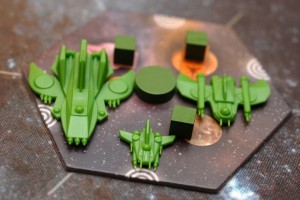
An Eclipse Dreadnought, Interceptor and Cruiser (from left to right) next to an influence disc and three population cubes – BGG.
II. The Combat Phase – “Battles are resolved and sectors conquered.” There being few battles until the last half or so of a game. Once a battle is resolved, involved players draw reputation tiles based on how well they performed, then any conquered solar systems are claimed.
The next phase in a turn is called “Upkeep.”
Note the added stand-up clips being used in an effort to hold down over-crowding
III. The Upkeep Phase – “Civilizations Upkeep costs are paid and Resources produced.” Players must pay the costs they’ve incurred during a turn. The more they have done, the more they owe. They will also get paid for whatever they’ve developed. If a player doesn’t have enough money to pay his costs directly he may pay with other resources at a 2 for 1 rate. If he still can’t pay he’s eliminated from the game.
And the last phase in a turn is Clean-Up.
IV. The Clean-Up Phase – ”Players move Influence Discs from the action spaces back to their Influence Track and new Technology Tiles are drawn.” This has the effect of lowering a player’s running costs for the next turn. Remember, in Eclipse, everything costs “Money,” “Science” or “Material” and just about everything you control produces either Money, Science or Materials. The trick is to produce more of them then your civilization consumes, while having a strong enough fleet to fend off your neighbors.
Victory:
Eclipse ends after 9 turns and whoever has the most Victory Points by then wins. VPs are earned for Reputation, Ambassadors, Discovery, Monoliths, progress on the technology track, species bonuses and tiles controlled. Players lose VP for attacking an empire after establishing diplomatic relations with it.
Conclusion:
 I have to say this game is highly thought of in the general gaming community and among our group of gamers. But I do feel that such an assessment should come with an asterisk. While these statements are true, it is also true that to get the most enjoyment out of this game you should not be allergic to long, complex games.
I have to say this game is highly thought of in the general gaming community and among our group of gamers. But I do feel that such an assessment should come with an asterisk. While these statements are true, it is also true that to get the most enjoyment out of this game you should not be allergic to long, complex games.
Now, you might not find Eclipse your cup of tea, but that’s a personal judgment. Its production values are outstanding. Plus the amount of development time put into it must have been phenomenal. Everything seems to have been thought out and there really isn’t anything you can point to and say, “this is where they were rushed.”
Of course, no game is perfect and I would have added a bit more interplayer conflict, but I guess if you are going to give people Twilight Imperium in half the time you’d got to abstract out something. Although, that being said, it’s still a superb rendition of the 4x theme. All the people I’ve played Eclipse with in two separate groups showed an interest in playing it again. And that’s not something I come across frequently. If you love Space Operas and don’t mind games that are slow to unfold give Eclipse a try.
Game Resources:


